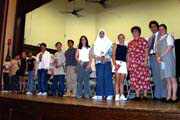As part of the regular curriculum at North Bergen’s Horace Mann Elementary School, all seventh and eighth grade students are required to create a project for the school’s Science Fair.
Despite the fact that participation is mandated, the 300 students who presented their projects last week found a way to have fun.
For example, when seventh grader Jessica Natale realized that she had to make a presentation, she figured that she could focus on something she has loved to do since she was an infant – planting.
“I’ve been planting since I was 13 months old,” said Natale, who was probably digging more than actual planting back then. “I’ve always loved growing things. It’s always been fun for me.”
So it was only natural that Natale’s Science Fair project would focus on an experiment involving the nutrients in plants and which soil helps plants grow better – in this example, a tomato plant.
“It was the first thing that came to my mind when I knew I had to have a project,” said Natale, who has a garden in her backyard that she monitors daily. “This was easy for me.”
Natale took soil from her backyard, from her neighborhood park, and some she purchased from the store. She then planted tomato seeds in each kind of soil and closely watched their progress, taking daily pictures, as well as keeping a journal.
The result?
“The one I planted in the store-bought soil grew the best,” said Natale, who took third place among seventh grade students for her project. “The ones that grew from the park and my yard grew mold.”
Added Natale, “I was surprised that I was able to win. It was a lot of fun and that’s the whole point about planting. It has to be fun. I’m going to continue to do it.”
Eighth grader Patrick Quiambao was the winner of the eighth grade class, with his project featuring an attempt to create electricity using solvents and metals.
Quiambao said that he was inspired to do something with electricity, because his grandfather is an electrician. “It’s a good topic to study,” Quiambao said.
Quiambao tried to find the right voltage in order to light a light bulb, using wire, baking soda, salt and vinegar and water.
“It took a lot of experimenting,” Quiambao said. “It was pretty hard to find the right solution. I was able to get some electricity, just not strong enough to light the light. It was a high voltage bulb.”
Fellow eighth grader Margaret Darias also had fun with her project, which she featured around sound and depth perception.
“I wanted to see if you could find out where sound was coming from when you’re blindfolded,” Darias said. “It was sort of like the game ‘Marco Polo’ that you play in the pool.”
So she used her younger brother, Phillip, as the subject.
“I blindfolded him and put him in the center of the room, from different spots, and called his name to see if he could find me,” Darias said. “It was a lot of fun, because I got the chance to boss my brother around a little.”
Darias’ project was also impressive, as she took home third place among eighth grade students.
According to eighth grade science teacher Karen Riser, who coordinated the Science Fair, along with seventh grade teacher Lisa Barone-Perez, the students were given an idea of the variety of topics that they could research for their projects.
“But a lot of them came up with ideas on their own,” Riser said. “That’s what really impressed me. One student [seventh grader Anthony Mir] was trying to see if he could cure staph infection by using yogurt. And he was successful. I was very proud of the caliber of work that they did. It was definitely a chance for the students to be creative and display skills that they don’t normally express.”
Some of the students were also able to do their lab research at Palisades Medical Center.
“That is an excellent opportunity for them,” Horace Mann School Principal Jorge Prado said. “Not only is it a chance to learn at a hospital, but it gives them the chance to be exposed to life outside the classroom. They can see practical things and work on their social skills.”
Top five received trophy
Each of the top five students in each grade received a trophy for their prize-winning projects, which were judged by a panel of people within the community. Each student received a certificate of participation.
“I really was impressed with their flexibility and creativity,” Prado said. “It wasn’t that way years ago. Back then, the projects were selected for the students and it wasn’t much fun. Now, the students have a hands-on approach and they seem to get their families involved more. That’s what makes it even better. It becomes a family activity. It’s education, but the kids seem to enjoy it as well.”
The fair also motivated some students to continue to study science in the future.
“It is one of my better subjects,” said Quiambao, who will head to North Bergen High School in the fall. “I like to study science. It’s something I will pursue.”
With results like that, the Science Fair was indeed a huge success.
